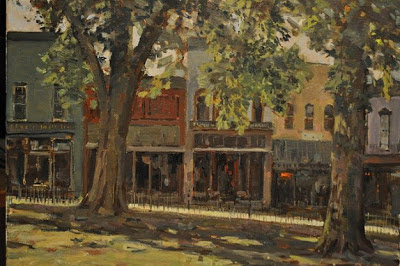 |
I make a lot of my own (canvasses) because I don't like the thinness of the commercially prepared canvasses. I usually apply 3 or 4 layers of acrylic gesso to a heavier than average canvas sanding lightly between each layer. The finished product still comes out rough as sandpaper. I'm afraid to use my favorite brushes on the first layer of paint.What is the fix for this and who makes a good commercially prepared canvas? Thanks!
.....................Myrtle Durgin
I can't think of any reason your canvas would come out rough other than the grade of sandpaper you are using. Your sandpaper must be too fine to take the surface of the gesso down sufficiently. Why don't you switch to a rougher grade of paper, and then use whatever fine paper you are probably already using. It seems a little counter intuitive to use a rougher paper to get a smoother surface than you have been getting. But with only a fine paper you don't rip down the tiny standing ridges left in the gesso from it's application. You need to start with that action and then when those are knocked down you can smooth the gesso out with a finer grade of paper.A middling grit like a 150 might just do both if you don't require a silky or glass like surface. I prefer to have a little more tooth on my substrate.
I keep two only grades of sandpaper in my studio. They are: 80 grit and 150 grit. The 80 will rip a passage of rough or too thick paint off the canvas quickly and mercilessly. You want to stop before you go too far with that! The 150 is good for smoothing things. You might possibly want to follow that up with a 100 grit if you prize a very smooth surface.
I don't use acrylic gesso, I did years ago. Real gesso is a different beast than the acrylic stuff put up in jars. I never prime my own canvas, preferring instead to buy it preprimed. I also don't like painting on canvas that is not oil primed. I think the paint handles better on an oil ground and looks better when you are finished too.
Here a word of caution, be very careful about sanding oil paintings. There are lots of deadly cadmiums etc. on that canvas. On your palette or brush they are safe enough as they are bound up in oil. If you sand your pictures they are flying around in the air as a toxic dust which you may aspirate. If I have to sand a painting, I often dip my sandpaper in mineral spirits from my palette and wet sand it. That is somewhat safer anyway.
I NEVER sand down an entire painting to reclaim the canvas, that releases way too much fine particulate dust. Canvas isn't THAT expensive. You asked me to recommend some canvas, I will recomend several. There are many fine canvasses and I haven't tried them all but here are some with which I am acquainted.
- CHEAP! Centurion DLX an oil primed linen that is around150 dollars a roll. It is a little thin but the price is right and I haven't had any problems with it. Find that here
- More expensive, Claessens type 12 High quality Belgian linen. Also oil primed. Silky under the brush. This is actually whats called a portrait linen. That means it is pretty smooth. Claessens makes rougher linens too if you prefer that. But this is my favorite. Here is that
- Also more expensive. Fredrix is an American made canvas. Another linen canvas. They make a lot of different sorts I like the Kent best. This used to be a lead primed canvas but is no longer. This is a really nice product. Go here for that....
- I don't use or recommend cotton canvas, but if you want to paint on cotton here is a link to Fredrix cotton canvasses of various grades. Of these I would prefer the Tyron or the Knickerbocker.
- The cheap cotton prestretched canvasses sold at the big box retail stores are junk.It would be better to paint on cinder blocks. I will use them sometimes for demo paintings when I am traveling, but they feels dreadful and scratchy under the brush and their absorbancy sucks the life out of your paint. Some of the big box stores do sell a better quality prestretched linen canvas at a higher price that are OK though.
Do you need a Take-it easel? (Gloucester easel) I know of someone who has a gently used one for sale. They want 150 dollars for it, plus shipping and handling, that's an excellent price. Please contact, Lois@loisgriffel.com
Interested in Snowcamp this year? A number of people have contacted me about that. I will announce the dates soon. Snowcamp is my winter painting workshop held in the White Mountains of New Hampshire.








